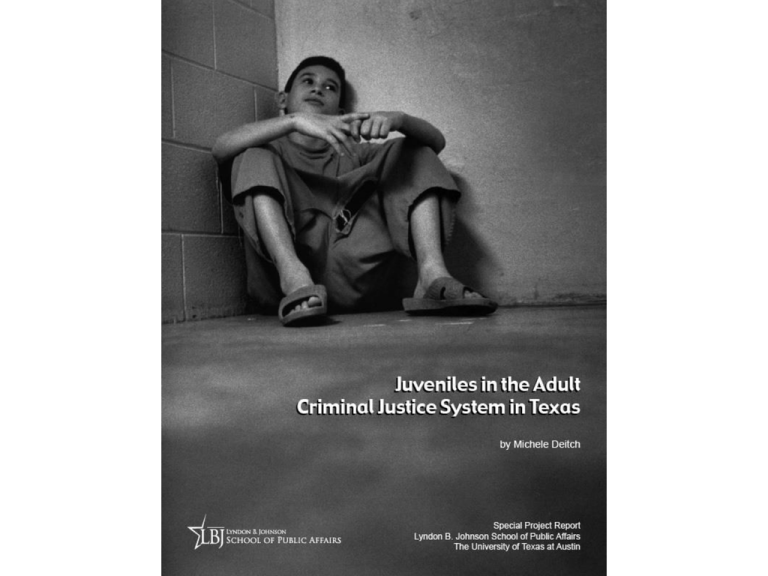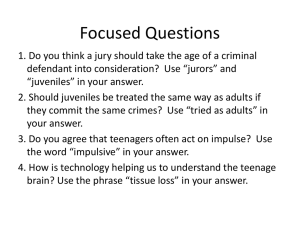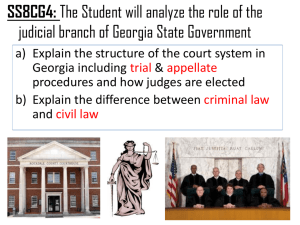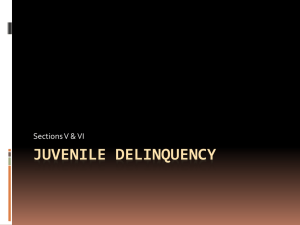
Juvenile Sentencing Options in Texas
Juvenile Indeterminate Sentencing
sentenced by juvenile judge
available for all offenses
can stay in TYC up until age 19 and then must be released
Determinate (Blended) Sentencing
sentenced by juvenile judge
available only for the most serious and violent offenses
sentences up to 40 years
start sentence in TYC, then possible transfer to adult prison at age
19 if not rehabilitated
Adult Certification
transferred by juvenile judge to adult criminal court
available for any felony offense, including state jail felonies and
non-violent crimes
sentences up to 99 years
start sentence in adult prison as early as age 14
Adult Certifications in Texas vs. Determinate Sentences with TYC Placement
FY 2005 – 10
Source: Texas Juvenile Probation Commission Data, 2010
Comparing Certified Juveniles and
Determinate Sentence Juveniles
Demographic Factors
Similar in age (mostly 16 year-olds in each
population)
Similar in gender breakdown (overwhelmingly
male)
Similar in ethnicity (disproportionately AfricanAmerican in both populations (40%))
Main difference is county of conviction
Number of Certifications and Determinate Sentences with TYC Placement
by County, FY 2006 - 09
Source: Texas Juvenile Probation Commission Data, 2010
Comparing Certified Juvenile and Determinate Sentence Populations
by Top 5 Offenses, FY 2005 - 09
CERTIFICATIONS
Offense
% of Total
Certifications
Aggravated
Robbery
Sexual Assault
Homicide*
35.2%
Aggravated
Assault
10.3%
Burglary
Other
TOTAL
5.6%
13.0%
100%
19.0%
17.0%
DETERMINATE SENTENCES
WITH TYC PLACEMENT
Offense
% of Total
Determinate
Sentences
Aggravated
Robbery
Sexual Assault
Aggravated
Assault
Violation of
Probation for
Sexual Assault
Homicide*
Other
TOTAL
Source: Texas Juvenile Probation Commission Data, 2010
* “Homicide” includes Capital Murder, Murder, Felony Murder, Manslaughter, Involuntary
Manslaughter, and Criminally Negligent Homicide.
40.7%
16.5%
16.5%
6.3%
4.8%
15.2%
100%
Comparing Criminal Offenses
Agg. Robbery cases dominate both populations, and
together with sexual assault, accounts for more than 55% of
cases in each category
Homicide only accounts for 17% of certification cases
(contrary to popular perception)
Determinate Sentence cases include almost exclusively
violent crimes, including homicide
Non-violent offenses, including state jail felonies, account for
10-15% of certification cases
Certified juveniles and Determinate Sentence juveniles
are relatively comparable when it comes to criminal
offenses. Certified youth are not demonstrably more
violent than youth retained in juvenile court.
Prior Referrals
for Certified Juveniles
FY 2005-09
Prior Referrals
Determinate Sentence
Juveniles
FY 2005-09
Source: Texas Juvenile Probation Commission Data, 2010
Comparing Criminal History
Certified youth and Determinate Sentence
youth have similar numbers of prior
referrals to juvenile court
Referrals can be for any offense, including truancy and
curfew violations
Roughly a quarter of each population have never been in
trouble before
Almost 45% have had either no prior referrals or only one
Dispels myth that certified youth are chronic, repeat
offenders
Prior Violent Referral
for Certified Juveniles,
FY 2005 -09
Prior Violent Referral
for Determinate Sentence
Juveniles
FY 2005-09
No Prior
Violent
Referral
65%
Source: Texas Juvenile Probation Commission Data, 2010
Prior Violent Criminal History?
Overwhelming majority of both Certified
juveniles and Determinate Sentence
juveniles do NOT have a prior history of
violence
Only 28% of the certified juveniles and 35% of the DS
juveniles had a prior referral for a violent offense
“Violent” includes felony-level offenses such as homicide,
attempted homicide, sexual assault, aggravated assault,
aggravated robbery, robbery, aggravated kidnapping,
kidnapping, weapons offenses, arson with injury or death,
and terroristic threat.
Prior TYC Commitment for Certified Juveniles
FY 2005 – 09
Source: Texas Juvenile Probation Commission Data, 2010
Beyond the Help of the
Juvenile Justice System?
9 out of 10 certified juveniles have not exhausted
the most serious options offered by the juvenile
system
Certified youth miss out on successful rehabilitative
programs in TYC, such as the Capital and Serious
Violent Offenders Program (95% success rate)
Majority have relatively minor and non-violent
criminal histories, and many are first-time offenders
Length of sentences for current youth age 19 and
under at TDCJ who were received prior to age 17
FY 2010
Sentence
length
#
Youthful
Offenders
% Youthful
Offenders
Less than 4
years
6
6.4%
4-10 yrs
49
52.1%
11-30 yrs
25
26.6%
31-40 yrs
5
5.3%
41 - Life
9
9.6%
TOTAL
94
100%
Source: Texas Department of Criminal Justice Data, 2010
Length of sentences for
Determinate Sentence youth in TYC
FY 2010
Sentence
length
#
%
Juveniles Juveniles
Less than 4
years
115
15.4%
4-10 yrs
461
61.8%
11-30 yrs
156
20.9%
31-40 yrs
14
1.9%
TOTAL
746
100%
Source: Texas Youth Commission Data, 2010
Most Certified juveniles will get out of
prison while still young
58% of certified juveniles in prison received
sentences of less than 10 years
Only 9 juveniles in recent years received sentences
longer than the 40 years available under determinate
sentencing
Similar sentence lengths for certified juveniles and
determinate sentence juveniles
But certified juveniles do not have access to the
rehabilitative programs they need for re-entry
Juveniles in
Adult Jails and Prisons
In Texas, Certified juveniles ages 14-17 are required to be
confined in:
Adult county jails, while awaiting trial, usually in isolation for a year
or more
Adult prisons, after conviction
In adult prisons and jails, juveniles face vastly higher risks of:
suicide
sexual assault
physical assault
mental illness
Limited access to effective therapeutic interventions,
education, specialized staff, and age-appropriate services
Public Safety Concerns
Center for Disease Control: “transferring
juveniles to the adult system is counterproductive as a strategy for preventing or
reducing violence”
one study found that transferred juveniles who
served at least a year in adult prison had a 100%
greater risk of violent recidivism
TDCJ Youthful Offender Program
(YOP)
Designed to keep juveniles separate from adults
Provides some limited therapeutic programming
Minimal opportunities for females
Inadequate educational, vocational, and recreational
opportunities for youth
Only 68% of the 14 – 17 year olds are in the YOP
32% of 14 – 17 year olds in TDCJ are in:
--state
jails
--transfer facilities
--administrative segregation
--medical and mental health facilities
where they receive NO specialized programming
and can be co-mingled with adult offenders
Compare to Programs at TYC
Determinate Sentence youth can participate in
Capital and Serious Violent Offenders Program (95%
success rate)
Sex Offender Treatment Program (94% success rate)
Educational classes (96% participation rate, compared
to 38% in YOP)
Special education
Basic treatment services for all youth
Other advantages of juvenile facilities
Specialized staff and age-appropriate services
No co-mingling with adult offenders
No long-term isolation
Conclusions
Data breaks down the common myths about which
juveniles get transferred to the adult system
Not the “worst of the worst”—many are first-time offenders, are charged
with non-violent offenses, and have no prior violent criminal history
Certified youth are almost identical to those retained in the juvenile
system in terms of criminality
Vast majority of certified juveniles have never been
through the toughest options in the juvenile system
Not a case of “nothing works”; rather “nothing has been tried”
Certified youth miss out on effective rehabilitative programs and school in
juvenile system
Determinate sentencing option is flexible—holds youth accountable while
protecting public safety with potentially long sentences
Adult jails and prisons are a poor fit for juveniles
Increases violent recidivism
Puts youth at extreme risk
Policy Recommendations
Limit certification to the most serious and violent
offenses, so that it is truly for the “worst of the worst”
Confine certified juveniles in juvenile detention facilities
instead of adult jails while they await trial
Confine certified juveniles in TYC instead of adult prison
until age 19, then transfer to prison to complete sentence
Protect public safety by allowing a juvenile judge to order
a 19-year old to complete rehabilitative programming in
TYC prior to release
Seek ways to keep more youth in the juvenile system
Relevant Legislation
HB 3351 (Turner) and HB 3698 (Gallego)
Limits certification to serious and violent offenses
HB 3350 (Turner)
Allows a juvenile judge to order a 19 y/o determinate
sentence youth to complete rehabilitative programming in
TYC prior to release
SB 1209 (Whitmire) and
CSHB 3303 (Marquez)
At county option, certified juveniles can be held in
juvenile detention center rather than adult jail while
awaiting trial
SB 1208 (Whitmire)
Extends term for determinate sentence probation to age
19 to keep lower-risk youth in juvenile system
For More Information:
Michele Deitch, J.D., M.Sc.
Senior Lecturer, LBJ School of Public Affairs
Michele.Deitch@mail.utexas.edu
512-328-8330
****
To download full report, visit:
http://www.utexas.edu/lbj/news/2011/juvenile-justice-report










